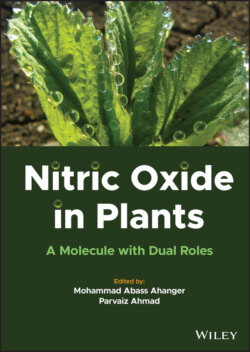Читать книгу Nitric Oxide in Plants - Группа авторов - Страница 26
2.4 Role of NO in Metabolic and Developmental Pathways
ОглавлениеNO has been shown to play an important role in the modulation of various physiological processes of plants mentioned in Table 2.1. Some of those processes include germination of seed and pollen, plant growth and development, closing and opening of stomata, senescence, flower development, and fruit ripening (Kopyra 2004; Delledonne 2005; Wilson et al. 2008). NO was documented to induce germination in light-dependent Arabidopsis and lettuce seeds, which indicates that NO takes part in root development (Li et al. 2016). Various NO donors stimulated root tip enlargement of Zea mays, in a dosage-related mode, and its length was prohibited by a NO scavenger (methylene blue) (Kopyra 2004). It has been proposed that NO and indole-3-acetic acid share some common steps in cell signaling, as they both stimulate the same plant response. Various studies have been suggested that stress regulates the endogenous levels of indole-3-acetic acid. As well as root growth and development, NO was found to be involved in the development and realignment of pollen tubes, best studied in A. thaliana (Pagnussat et al. 2003, 2004). It has been reported that NO has also been involved in the synthesis of several biological constituents including saponin and phytoalexin (Pagnussat et al. 2003, 2004).
Table 2.1 Role of nitric oxide (NO) during abiotic stress.
| Abiotic stress | NO-mediated effect | Plant species | Reference |
| Drought | Abscisic acid signaling and closure of stomata | Pisum sativum | Syed Nabi et al. 2019 |
| Salt | Increased tolerance of root growth | Oryza sativaNicotiana tabacum | van Zelm et al. 2020 |
| Heavy metals | Heightened response in terms of root growth and oxidative stress | LupinusChlorella vulgaris | Solórzano et al. 2020 |
| Temperature | Release of NO and increased tolerance of seedlings | Oryza sativaNicotiana tabacum | Syed Nabi et al. 2019 |
| Ultraviolet radiation | Nitric oxide synthase activity | Arabidopsis thaliana | Tossi et al. 2009 |
Plants have established multifaceted innate/induced and hypersensitive mechanisms (HR) to protect themselves from pathogenic microorganisms, which subsequently terminate in systemic acquired resistance (SAR). An initial significant event is the elevation of Ca2+by using the plasma membrane cyclic nucleotide-gated ion channels (CNGCs). This is consistent with a role for cyclic guanosine monophosphate (cGMP) in plants, and various putative guanylate cyclase activity proteins including phytosulfokine receptor (PSKR). In PSKR, the cytosolic guanylate cyclase domain is activated by its biologically active ligand, a sulfonated phytosulfokine. An increase in Ca2+triggers the creation of SA, NO, and reactive oxygen species (ROS), which stimulates apoptosis in the proximity of the infection, thereby restraining pathogen progression (Heath 2000; Mur et al. 2019; Noman et al. 2020).
